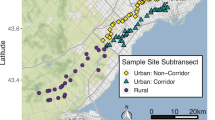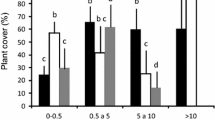Abstract
Mangrove forests worldwide undergo anthropogenic fragmentation that may threaten their existence, and yet there have been few tests of the effects of fragmentation on demographic processes critical for mangrove regeneration. Predicting the effects of habitat fragmentation on mangroves is problematic as pollinators may move more freely across water than terrestrial habitat, and propagules can be widely dispersed by water. Here, within each of two estuaries, we compared pollinator diversity and activity, reproductive effort and output, and rates of recruitment for sets of three large (>1500 trees), medium (300–500) and small (<50) stands. As predicted, most measures of reproductive activity and success were inversely related to stand size with large stands typically producing significantly more and larger fruit, and significantly more seedlings. Most strikingly, we found the effect of fragmentation on the abundance of pollinators (honeybees), the production and quality of fruit and the survival rate of seedlings to be similar, showing significant reduction of recruitment in small stands. This study provides the first rigorous evidence that recruitment of mangroves, like for many terrestrial plants, is negatively impacted by habitat fragmentation. From a management perspective, we argue that in the short term our data imply the importance of conserving the largest possible stands. However, additional work is needed to determine (1) the proportion of recruits within small stands that originate within large stands, (2) how seedling performance varies with fruit size and genotype, and (3) how seedling size and performance vary with the abundance and diversity of pollen.




Similar content being viewed by others
References
Adam P (2002) Saltmarshes in a time of change. Environ Conserv 29:39–61. doi:10.1017/S0376892902000048
Aguilar R, Ashworth L, Galetto L, Aizen MA (2006) Plant reproductive susceptibility to habitat fragmentation: review and synthesis through a meta-analysis. Ecol Lett 9:968–980. doi:10.1111/j.1461-0248.2006.00927.x
Aizen MA, Ashworth L, Leonardo G (2002) Reproductive success in fragmented habitats: do compatibility systems and pollination specialization matter? J Veg Sci 13:885–892. doi:10.1111/j.1654-1103.2002.tb02118.x
Barbeta A, Penuelas J, Ogaya R, Jump AS (2011) Reduced tree health and seedling production in fragmented Fagus sylvatica forest patches in the Montseny Mountains (NE Spain). Forest Ecol Manag 261:2029–2037. doi:10.1016/j.foreco.2011.02.029
Baskin CC, Baskin JM (2001) Seeds: ecology, biogeography, and evolution of dormancy and germination. Academic Press, San Diego. ISBN-10: 0124166776
Cavanaugh KC, Kellner JR, Forde AJ, Gruner DS, Parker JD, Rodriguez W, Feller IC (2013) Poleward expansion of mangroves is a threshold response to decreased frequency of extreme cold events. Proc Natl Acad Sci USA 111:723–727. doi:10.1073/pnas.1315800111
Clarke PJ (1993) Dispersal of gray mangrove (Avicennia marina) propagules in southeastern Australia. Aquat Bot 45:195–204. doi:10.1016/0304-3770(93)90021-N
Clarke PJ, Myerscough PJ (1991) Floral biology and reproductive phenology of Avicennia marina in Southeastern Australia. Aust J Bot 39:283–293. doi:10.1071/BT9910283
Collinge SK (2009) Ecology of fragmented landscapes. Johns Hopkins University Press, Boltimore. ISBN 9780801891380
Cunningham SA (2000) Depressed pollination in habitat fragments causes low fruit set. Proc Roy Soc B Biol Sci 267:1149–1152. doi:10.1098/rspb.2000.1121
Duke NC (2006) Australia’s mangroves. The authoritative guide to Australia’s mangrove plants. University of Queensland, Brisbane. ISBN 9780646461960
Duke NC, Meynecke J-O, Dittmann S, Ellison MA, Anger K, Berger U, Cannicci S, Diele K, Ewel KC, Field CD, Koedam N, Lee SY, Marchand C, Nordhaus I, Dahdouh-Guebas F (2007) A world without mangroves? Science 317:41–42. doi:10.1126/science.317.5834.41b
Dunstan DJ (1990) Some early environmental problems and guidelines in New South Wales estuaries. Wetlands (Australia) 9:1–6
Ghazoul J (2005) Pollen and seed dispersal among dispersed plants. Biol Rev 80:413–443. doi:10.1017/S1464793105006731
Gilpin A-M, Ayre DJ, Denham AJ (2014) Can the pollination biology and floral ontogeny of the threatened Acacia carneorum explain its lack of reproductive success? Ecol Res 29:225–235. doi:10.1007/s11284-013-1117-y
Gross CL, Mackay D (1998) Honeybees reduce fitness in the pioneer shrub Melastoma affine (Melostomataceae). Biol Conserv 86:169–178. doi:10.1016/S0006-3207(98)00010-X
Hermansen TD (2013) Reproductive biology and genetic structure in fragmented population of the temperate mangrove Avicennia marina. PhD Dissertation, School of Biological Sciences, University of Wollongong, North Wollongong, New South Wales, Australia http://ro.uow.edu.au/theses/4014/
Hermansen TD, Ayre DJ, Minchinton TE (2014a) Reduced pollinator density leads to reduced fruit set and quality in small stands of temperate Avicennia marina. Plant Ecol 215:1153–1162. doi:10.1007/s11258-014-0374-3
Hermansen TD, Britton DR, Ayre DJ, Minchinton TE (2014b) Identifying the real pollinators? Exotic honeybees are the dominant flower visitors and only effective pollinators of Avicennia marina in Australian temperate mangroves. Estuar Coast 37:621–635. doi:10.1007/s12237-013-9711-3
Hermansen TD, Roberts DG, Toben M, Ayre DJ, Minchinton TE (2015) Small urban stands of the mangrove Avicennia marina are genetically diverse but experience elevated inbreeding. Estuar Coast 38:1898–1907. doi:10.1007/s12237-015-9955-1
Homer L (2009) Population structure and distance of gene flow in Avicennia marina (Forsk.) Vierh. (Avicenniaceae) on a local/regional scale in the Northern Rivers of New South Wales, Australia. PhD Dissertation, School of Environmental Science and Management, Southern Cross University, New South Wales, Australia. http://epubs.scu.edu.au/theses/191/
Jacquemyn H, Brys R, Hermy M (2002) Patch occupancy, population size and reproductive success of a forest herb (Primula elatior) in a fragmented landscape. Oecologia 130:617–625. doi:10.1007/s00442-001-0833-0
Jules ES, Rathcke BJ (1999) Mechanisms of reduced Trillium recruitment along edges of old-growth forest fragments. Conserv Biol 13:784–793. doi:10.1046/j.1523-1739.1999.97435.x
Kathiresan K, Bingham BL (2001) Biology of mangroves and mangrove ecosystems. Adv Mar Biol 40:81–251. doi:10.1016/S0065-2881(01)40003-4
Kato M, Shibata A, Yasui T, Nagamasu H (1999) Impact of introduced honeybees, Apis mellifera, uponnative bee communities in the Bonin (Ogasawara) Islands. Res Popul Ecol 41:217–228. doi:10.1007/s101440050025
McLoughlin LC (2000) Estuarine wetlands distribution along the Parramatta River, Sydney, 1788–1940: implications for planning and conservation. Cunninghamia 6:579–610
Minchinton TE (2001) Canopy and substratum heterogeneity influence recruitment of the mangrove Avicennia marina. J Ecol 89:888–902. doi:10.1046/j.0022-0477.2001.00599.x
Minchinton TE (2006) Consequences of pre-dispersal damage by insects for the dispersal and recruitment of mangroves. Oecologia 148:70–80. doi:10.1007/s00442-005-0351-6
Minchinton TE, Dalby-Ball M (2001) Frugivory by insects on mangrove propagules: effects on the early life history of Avicennia marina. Oecologia 129:243–252. doi:10.1007/s004420100715
Moeller DA, Geber MA, Eckhart VM, Tiffin P (2012) Reduced pollinator service and elevated pollen limitation at the geographic range limit of an annual plant. Ecology 93:1036–1048. doi:10.1890/11-1462.1
Murcia C (1995) Edge effects in fragmented forests: implications for conservation. Trends Ecol Evol 10:58–62. doi:10.1016/S0169-5347(00)88977-6
Nayak KG, Davidar P (2010) Pollinator limitation and the effect of breeding systems on plant reproduction in forest fragments. Acta Oecol 36:191–196. doi:10.1016/j.actao.2009.12.004
Newman BJ, Ladd P, Brundrett M, Dixon KW (2013) Effects of habitat fragmentation on plant reproductive success and population viability at the landscape and habitat scale. Biol Conserv 159:16–23. doi:10.1016/j.biocon.2012.10.009
Paton DC (1993) Honeybees in the Australian environment: does Apis mellifera disrupt or benefit the native biota? Bioscience 43:95–103. doi:10.2307/1311970
Rogers K (2004) Mangrove and saltmarsh surface elevation dynamics in relation to environmental variables in Southeastern Australia. PhD Dissertation, School of Earth and Environmental Sciences, University of Wollongong, North Wollongong, New South Wales, Australia. http://ro.uow.edu.au/theses/653/
Roubik DW (1996) African honey bees as exotic pollinators in French Guiana. In: Matheson A, Buchmann SL, O’Toole C, Westrich P, Williams IH (eds) The conservation of bees. Linnean society symposium series, vol 18. Academic Press, London, pp 173–182. ISBN: 0124797407
Saenger P (2003) Mangrove ecology, silviculture and conservation. Kluver Academic Publishers, Dordrecht. ISBN 978-94-015-9962-7
Simpson MG (2006) Plant systematics. Elsevier Academic Press, San Diego. ISBN 9780080922089
Steffan-Dewenter I, Tscharntke T (2000) Resource overlap and possible competition between honey bees and wild bees in central Europe. Oecologia 122:288–296. doi:10.1007/s004420050034
Stokes D (2010) The physical and ecological impacts of mangrove expansion and mangrove removal: Tauranga Harbour, New Zealand. PhD Dissertation, University of Waikato, Hamilton, New Zealand. http://researchcommons.waikato.ac.nz/handle/10289/4902
Thorogood CA (1985) Changes in the distribution of mangroves in the Port Jackson-Parramatta River estuary from 1930 to 1985. Wetlands (Australia) 5:91–96
Tomlinson PB (1986) The botany of mangroves. Cambridge University Press, Cambridge. ISBN 0521255678
Vaughton G (1996) Pollination disruption by European honeybees in the Australian bird-pollinated shrub Grevillea barklyana (Proteaceae). Plant Syst Evol 200:89–100. doi:10.1007/BF00984750
West RJ, Thorogood CA, Walford TR, Williams RJ (1985) An estuarine inventory for New South Wales, Australia. Fisheries Bulletin 2, Department of Agriculture, New South Wales
Westerkamp C (1991) Honeybees are poor pollinators—why? Plant Syst Evol 177:71–75. doi:10.1007/BF00937827
Whelan RJ, Ayre DJ, Beynon FM (2009) The birds and the bees: pollinator behaviour and variation in the mating system of the rare shrub Grevillea macleayana. Ann Bot 103:1395–1401. doi:10.1093/aob/mcp091
Acknowledgements
This study was supported by a University of Wollongong postgraduate scholarship to Tyge D. Hermansen, by Australian Research Council Discovery Project Grant DP0666787 to David J. Ayre and Todd E. Minchinton and by the Centre for Sustainable Ecosystem Solutions at the University of Wollongong.
Author information
Authors and Affiliations
Contributions
TDH designed and performed the experiments, analysed the data and wrote the manuscript. TEM and DJA gave invaluable support and supervision in relation to study design and performance, statistical analysis and manuscript production.
Corresponding author
Additional information
Communicated by Anne Worley.
Electronic supplementary material
Below is the link to the electronic supplementary material.
Rights and permissions
About this article
Cite this article
Hermansen, T.D., Minchinton, T.E. & Ayre, D.J. Habitat fragmentation leads to reduced pollinator visitation, fruit production and recruitment in urban mangrove forests. Oecologia 185, 221–231 (2017). https://doi.org/10.1007/s00442-017-3941-1
Received:
Accepted:
Published:
Issue Date:
DOI: https://doi.org/10.1007/s00442-017-3941-1




